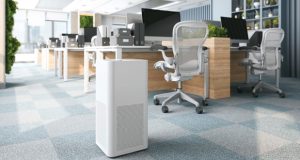Interactive 3D visualisation and augmented reality offer the FM a dynamic new toolkit for training staff and managing assets
Virtual reality (VR) applications immerse the user in a computer-generated environment to provide a powerfully engaging experience. Augmented reality (AR) adds elements such as computer-generated graphics or data to a live representation of a real-world environment. Combined, these technologies have the potential to transform employee training programmes, as well as assist FMs in the efficient management of buildings and estates.
It’s estimated that by 2020 a third of the UK workforce will be aged over 50, with many approaching retirement. This will potentially create a shortage of skilled workers across a range of industries. VR and AR can take education and training to the next level, enabling employers to build realistic scenarios that equip their employees with the knowledge and information they need in a safe, cost-effective environment.
Seeable is one of a handful of organisations providing AR, VR and interactive 3D applications to the UK FM industry. Managing Director Nick Blenkharn explains: “When you ask most people about their knowledge or experience with AR, it’s usually through computer games such as Pokemon Go. The rapid advance of technology has enabled us to combine the real and the virtual world for use within business, providing a powerful training and business tool.”
AR enables users to visualise buildings, interiors and assets in a digital environment. “Allowing employees to navigate through a building even before it is built, be safely trained on the machinery or equipment vital to their job, or locate hidden hazards becomes so much easier than the traditional method of using stacks of files, plans and PDFs,” says Blenkharn.
The benefit comes not only through training and awareness, but in knowledge management and access to information. “Take operation and maintenance manuals for key equipment as an example,” he says. “PDF O&M manuals could be accessed by the click of an information icon with a 3D representation of the equipment. Progress this further via another icon which accesses a video explaining how to operate it, and another linking to the health and safety system for details of past accidents and warnings of near misses.”
By holding up an AR-enabled mobile device to an asset or piece of equipment, the employee could generate a virtual view of the inner workings, training guides or even a live data feed of performance metrics. “Workforce training implemented through augmented reality and visualisation technology provides so many more advantages and is already so far ahead of traditional learning methods that there really is no fair comparison,” Blenkharn claims.
THE DIGITAL TWIN
Interactive 3D, VR and AR are just new ways to communicate information in an accessible, user-friendly manner. In the 1980s, the mouse was an amazing tool enabling people to access and exploit the power of computers. With the rise of laptops came trackpads, and now with the advent of smartphones, touchscreens and VR headsets we are enjoying another leap forward with how we access and interact with information.
For FMs, the potential uses are obvious. Many facilities are still managed with out-of-date 2D floor or fire plans. AR and VR technology allows for the facility to be captured as a 3D digital representation, or twin, augmented with the information needed to manage it efficiently. This method of linking data to items and locations in the real world is called georeferencing.
Seeable creates the twin in several ways. Existing architectural and engineering designs and data can be used, or BIM-compliant designs, with a visualisation tool to make it easy – no need for special Cad training. If the facility is being updated, refurbished or extended, 3D laser scanning and modelling can be employed. If there are multiple buildings or sites, vehicle-based mobile mapping at ground level and drone mapping at roof level can provide comprehensive coverage. Where the facility is likely to be unchanged, Blenkharn explains that a quick and efficient technique called rapid simultaneous localisation and mapping (Slam) can be used.
Once the digital twin has been created, it can be deployed or augmented in various ways depending on the FM’s requirements. These might relate to safety, compliance or maintenance issues, construction planning or ongoing utilisation of a space by the occupant.
“The answer is to create once and use for many purposes,” says Blenkharn. “You could create a simplified version of the digital twin for navigation and wayfinding at the front desk, for example, while augmenting the full version with key or pass number information for the security office.” Workers could be inducted or trained using embedded 360° virtual tours, saving time and minimising disruption in the real-world environment.
DATA VISUALISATION
The internet of things (IoT) is another key technology on the rise. Many of us already use IoT data without knowing it – when the outside temperature is fed to a mobile weather app, for example, or the live traffic flow is shown on Google maps. If sensors are added to a facility, or already exist to report room occupancy, temperature or electricity use, then the data they generate can be sampled, stored online and fed to the facility’s digital twin.
Visualisation tools can present complex data and information much more clearly – representing room temperature as a colour gradient, for example, and occupancy as a chart, enabling the FM to see at a glance where heat is being wasted on empty space. Better visualisation could aid space planning decisions, enabling more efficient utilisation of existing space.
Organisations need to study the possibilities, see what’s available and work out what the new tools can do for them. It’s important not to be diverted by flashy, ‘techy’ solutions with no real benefit. Used properly, new visualisation technology can be a powerful aid in implementing the efficiencies and smarter ways of working that will be key to survival in a changing world.




